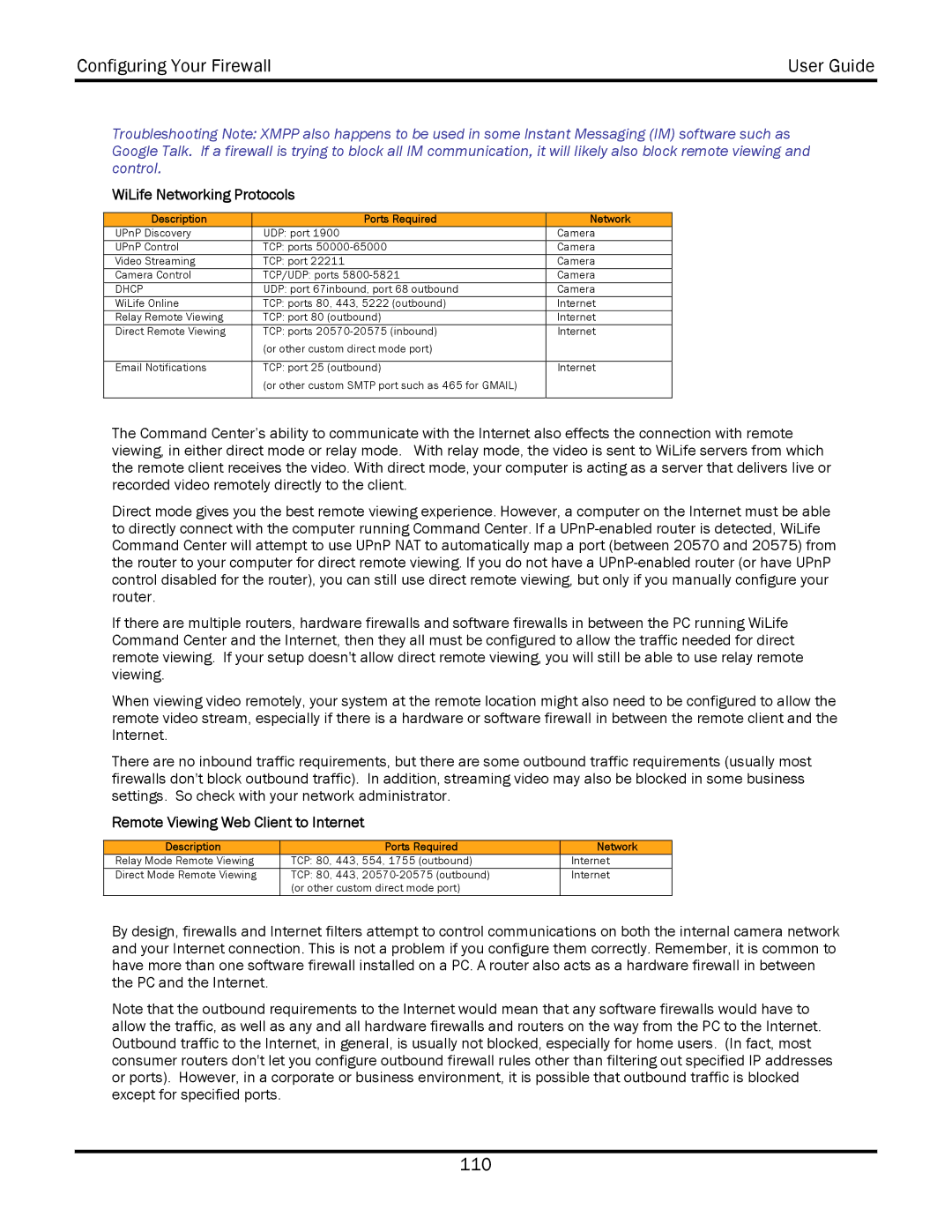
Configuring Your Firewall | User Guide |
|
|
Troubleshooting Note: XMPP also happens to be used in some Instant Messaging (IM) software such as Google Talk. If a firewall is trying to block all IM communication, it will likely also block remote viewing and control.
WiLife Networking Protocols
Description | Ports Required |
UPnP Discovery | UDP: port 1900 |
UPnP Control | TCP: ports |
Video Streaming | TCP: port 22211 |
Camera Control | TCP/UDP: ports |
DHCP | UDP: port 67inbound, port 68 outbound |
WiLife Online | TCP: ports 80, 443, 5222 (outbound) |
Relay Remote Viewing | TCP: port 80 (outbound) |
Direct Remote Viewing | TCP: ports |
| (or other custom direct mode port) |
|
|
Email Notifications | TCP: port 25 (outbound) |
| (or other custom SMTP port such as 465 for GMAIL) |
|
|
Network
Camera
Camera
Camera
Camera
Camera
Internet
Internet
Internet
Internet
The Command Center’s ability to communicate with the Internet also effects the connection with remote viewing, in either direct mode or relay mode. With relay mode, the video is sent to WiLife servers from which the remote client receives the video. With direct mode, your computer is acting as a server that delivers live or recorded video remotely directly to the client.
Direct mode gives you the best remote viewing experience. However, a computer on the Internet must be able to directly connect with the computer running Command Center. If a
If there are multiple routers, hardware firewalls and software firewalls in between the PC running WiLife Command Center and the Internet, then they all must be configured to allow the traffic needed for direct remote viewing. If your setup doesn't allow direct remote viewing, you will still be able to use relay remote viewing.
When viewing video remotely, your system at the remote location might also need to be configured to allow the remote video stream, especially if there is a hardware or software firewall in between the remote client and the Internet.
There are no inbound traffic requirements, but there are some outbound traffic requirements (usually most firewalls don't block outbound traffic). In addition, streaming video may also be blocked in some business settings. So check with your network administrator.
Remote Viewing Web Client to Internet
Description | Ports Required |
Relay Mode Remote Viewing | TCP: 80, 443, 554, 1755 (outbound) |
Direct Mode Remote Viewing | TCP: 80, 443, |
| (or other custom direct mode port) |
Network
Internet
Internet
By design, firewalls and Internet filters attempt to control communications on both the internal camera network and your Internet connection. This is not a problem if you configure them correctly. Remember, it is common to have more than one software firewall installed on a PC. A router also acts as a hardware firewall in between the PC and the Internet.
Note that the outbound requirements to the Internet would mean that any software firewalls would have to allow the traffic, as well as any and all hardware firewalls and routers on the way from the PC to the Internet. Outbound traffic to the Internet, in general, is usually not blocked, especially for home users. (In fact, most consumer routers don't let you configure outbound firewall rules other than filtering out specified IP addresses or ports). However, in a corporate or business environment, it is possible that outbound traffic is blocked except for specified ports.
110
